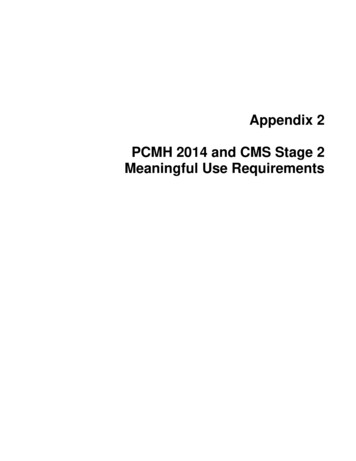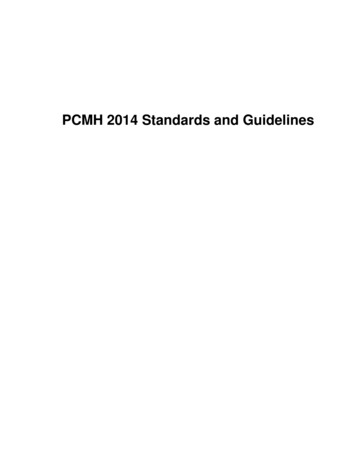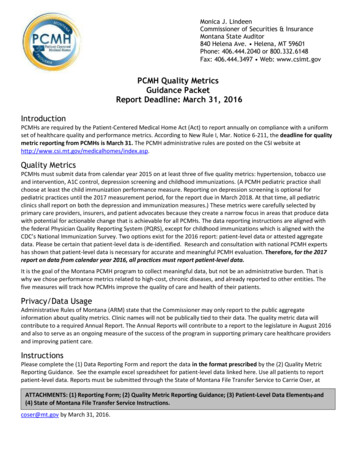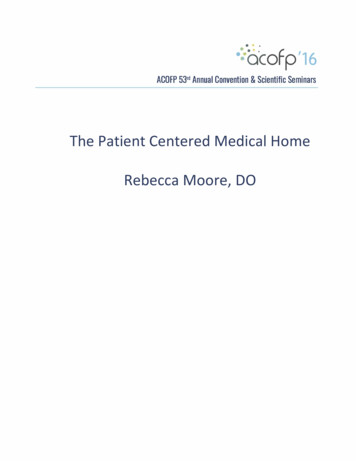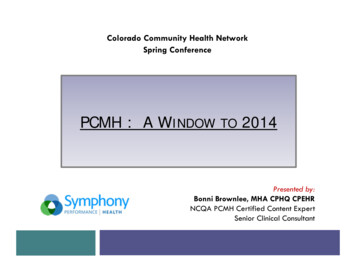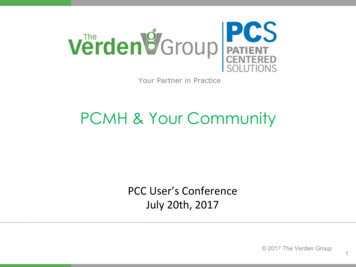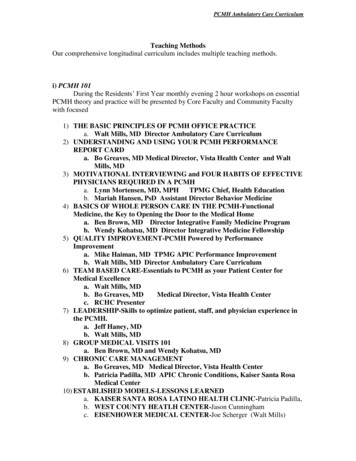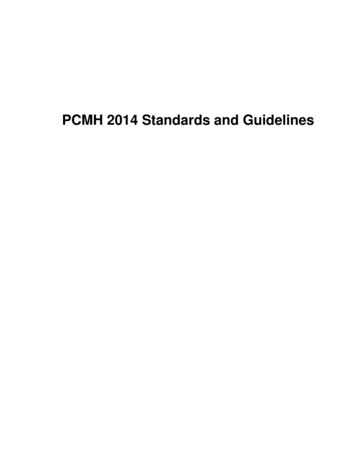
Transcription
PCMH 2014 Standards and Guidelines
28NCQA Patient-Centered Medical Home (PCMH) 2014July 28, 2014
PCMH 1: Patient-Centered AccessPCMH 1: Patient-Centered Access2910.00 pointsThe practice provides access to team-based care for both routine and urgent needs ofpatients/families/caregivers at all times.Element A: Patient-Centered Appointment Access (MUST-PASS)4.50 pointsThe practice has a written process and defined standards for providingaccess to appointments, and regularly assesses its performance on:YesNo1. Providing same-day appointments for routine and urgent care.(CRITICAL FACTOR) 2. Providing routine and urgent-care appointments outside regularbusiness hours. 3. Providing alternative types of clinical encounters. 4. Availability of appointments. 5. Monitoring no-show rates. 6. Acting on identified opportunities to improve access. ScoringExplanation100%The practicemeets 5-6factors(includingfactor 1)75%The practicemeets 3-4factors(includingfactor 1)50%The practicemeets 2factors(includingfactor 1)25%The practicemeets 1 factor(includingfactor 1)0%The practicemeets 0factorsMUST-PASS elements are considered the basic building blocks of a patientcentered medical home. Practices must earn a score of 50% or higher. All sixmust-pass elements are required for recognition.All practices, including those with walk-in access, must make same-day scheduledappointments available and must monitor their availability. Walk-in access is anapproach to patient appointment scheduling that allows established patients to beseen by a member of the care team during regular office hours, without prior notice.The practice has a written policy for making appointments available for both urgentand routine issues. The policy states time requirements and defines “routine” and“urgent.” For example, the practice has a policy that urgent issues are seenimmediately and routine visits (e.g., new-patient physicals, return-visit exams tomonitor mild acute and chronic conditions) are scheduled within seven days.The practice triages patients to determine the urgency of a request for a same-dayappointment; triage considers patient care need and preference.Patients access the clinician and care team for routine and urgent care needs byoffice visit, by telephone or through secure electronic messaging.Factor 1: Factor 1 is a critical factor and must be met for practices to receive ascore on this element. Since this is also a must pass element, failure to meetfactor 1 will result in denial of recognition.The practice reserves time for same-day appointments (also referred to as “same-dayscheduling”) for routine and urgent care based on patient preference and need.Adding ad hoc or unscheduled appointments to a full day of scheduled appointmentsdoes not meet the requirement.July 28, 2014NCQA Patient-Centered Medical Home (PCMH) 2014
30PCMH 1: Patient-Centered AccessThe practice has a process for scheduling same-day visits for patients with routine andurgent needs, and monitors use of same-day appointments to ensure that patients areable to use this feature.Factor 2: The practice schedules appointments outside a typical daytime schedule. Forexample a practice may open for appointments at 7am or remain open until 8 pm oncertain days or it may be open two Saturdays each month.Providing extended access does not include: Opening daytime appointments when a practice would otherwise be closed forlunch (on some or most days). Opening daytime appointments when a practice would otherwise close early (e.g.,a weekday afternoon or holiday).Practices are encouraged to first assess the needs of their patients for appointmentsoutside normal business hours and then to evaluate if these appointment times meetthe needs of the patients. If the practice does not provide care beyond regular officehours (e.g., a small practice with limited staffing), it may arrange for patients to receivecare from other (non-ER) facilities or clinicians.Factor 3: An alternative type of clinical encounter is a scheduled meeting betweenpatient and clinician using a mode of real-time communication in lieu of a traditionalone-on-one in-person office visit; for example, standalone communication or acombination of telephone, video chat and secure instant messaging. Group visits wherethe patient is one of several patients scheduled for care and education at the same timealso qualifies as an ‘alternative type of clinical encounter.’Unscheduled alternative clinical encounters, including clinical advice by telephone andsecure electronic communication (e.g., electronic message, Web site) during officehours do not meet the requirement.Factor 4: The practice has standards for appointment availability. Availability standardsmay be established and measured for a variety of appointment types, including urgentcare, new patient physicals, routine exams and return-visit exams or the practice mayset a single standard across all appointment types (e.g. open access for all). Onecommon approach to measuring appointment availability against standards is todetermine the third next available appointment for each appointment type, with an openaccess goal of zero days (same-day availability). Third next available appointmentmeasures the length of time from when a patient contacts the practice to request anappointment, to the third next available appointment on the clinician’s schedule. TheInstitute for Healthcare Improvement (IHI) identified third next available appointmenttracking as “a more sensitive reflection of true appointment availability.” IHI has set agoal of zero days for primary hirdNextAvailableAppointment.aspx). Aclinician’s panel may be closed, but appointment availability may not be based onpayer.Factor 5: To provide consistent access and help understand true demand, practicesmonitor no-show rates. No-show rates may be calculated by taking the number ofpatients who did not keep their pre-scheduled appointments during a specific period oftime (i.e. a session or a day) divided by the number of patients who were pre-scheduledto come to the center for appointments during the same period of time (Primary CareDevelopment Corporation).Factor 6: To expand access and capacity, the practice uses information gathered fromreports in factors 1–5 to identify opportunities to improve access.The practice may participate in or implement a rapid-cycle improvement process, suchas Plan-Do-Study-Act (PDSA), that represents a commitment to ongoing qualityimprovement and goes beyond setting goals and taking action.Resource: One resource for the PDSA cycle is the Institute for Healthcare Improvement(IHI): entMethods/HowToImprove/.NCQA Patient-Centered Medical Home (PCMH) 2014July 28, 2014
PCMH 1: Patient-Centered Access31DocumentationFor all factors that require a documented process for staff, the documented processfor staff includes a date of implementation or revision and has been in place for at leastthree months prior to submitting the PCMH 2014 Survey Tool.Factor 1: NCQA reviews a documented process for scheduling same-day appointmentsthat includes defining their appointment types. NCQA reviews a report with at least fivedays of data, showing the availability and use of same-day appointments for both urgentand routine care.Factor 2: NCQA reviews a documented process for staff to follow for arranging afterhours access with other practices or clinicians and provides a report showing afterhours availability or materials provided to patients demonstrating that the practiceprovides regular extended hours. NCQA reviews a report with at least five days of data,showing availability and use of appointments outside the normal hours of operation. Aprocess for arranging after-hours access is not required if the practice has regularextended hours.Factor 3: NCQA reviews a documented process for arranging appointments foralternative types of encounters (e.g., telephone, group visits, video chat). NCQAreviews a report of encounter types and dates that includes frequency of scheduledalternative encounter types in a recent 30-calendar-day period.Ad hoc telephone or email exchanges do not meet the requirement.Factor 4: NCQA reviews a documented process defining the practice’s standards fortimely appointment availability (e.g., within 14 calendar days for physicals, within 2 daysfor follow-up care, same day for urgent care needs) and for monitoring against thestandards. NCQA reviews a report with at least five days of data showing appointmentwait times, compared with defined standards.Factor 5: NCQA reviews a documented process for monitoring scheduled visits. NCQAreviews a report from a recent 30-calendar-day period showing number of scheduledvisits; number of patients actually seen, number of no-shows; and a calculated rateusing scheduled visits as the denominator and patients seen as the numerator or bytaking the number of patients who did not keep their pre-scheduled appointments duringa specific period of time (i.e. a session or a day) divided by the number of patients whowere pre-scheduled to come to the center for appointments during the same period oftime.Factor 6: NCQA reviews a documented process for selecting, analyzing and updatingits approach to creating access to appointments that considers appointment supply andpatient demand by: Including criteria for selecting areas of focus. Describing how the practice monitors areas of focus. Describing how the practice sets targets for improvement. Specifying how often criteria for creating greater access to appointments arerevisited. Outlining when targets may be adjusted.NCQA reviews a report showing the practice has evaluated data on access, selected atleast one opportunity to improve access and took at least one action to create greateraccess.July 28, 2014NCQA Patient-Centered Medical Home (PCMH) 2014
32PCMH 1: Patient-Centered AccessElement B: 24/7 Access to Clinical Advice3.50 pointsThe practice has a written process and defined standards for providingaccess to clinical advice and continuity of medical record information atall times, and regularly assesses its performance on:YesNo1. Providing continuity of medical record information for care and advicewhen office is closed. 2. Providing timely clinical advice by telephone. (CRITICAL FACTOR) 3. Providing timely clinical advice using a secure, interactive electronicsystem. 4. Documenting clinical advice in patient records. ScoringExplanation100%The practicemeets all 4factors75%The practicemeets 3factors(includingfactor 2)50%The practicemeets 2factors(includingfactor 2)25%The practicemeets 1 factor(or does notmeet factor 2)NA 0%The practicemeets 0factorsFactor 1: The practice makes patient clinical information available to on-call staff,external facilities, and other clinicians outside the practice when the office is closed .Access to the medical record may include direct access to the paper or electronicrecord or by arranging a telephone consultation with a clinician who has access to themedical record.If care is provided by a facility that is not affiliated with the practice or does not haveaccess to patient records, the practice provides patients with an electronic or printedcopy of a clinical summary of their medical record. One option may be for patients toconvey needed information via individualized care plans or portable personal healthrecords, or through patient access to an electronic health record (EHR).Telephone consultation with the primary clinician or with a clinician who has access tothe patient’s medical record meets the requirement. The practice’s process forensuring access includes a method for ensuring access by practice clinicians whenthe office is closed.Factors 2, 3: Factor 2 is a critical factor and must be met for practices to scorehigher than 25% on this element.Patients can seek and receive interactive (i.e., questions are answered by a person,rather than by a recorded message) clinical advice by telephone (factor 2) or secureelectronic communication (factor 3) (e.g., electronic message, Web site) when theoffice is open and closed.Clinicians return calls and respond to secure electronic messages in the time framedefined by the practice to meet the clinical needs of the patient population.The practice may have different standards for when the office is open and when theoffice is closed and may have different standards for electronic versus telephoniccommunications.Factor 3: If patients can submit requests for clinical advice after office hours, thepractice has an obligation to provide a timely response. The practice defines thetypes of inquiries that should be made electronically, and its response time frame(e.g., a secure message sent after hours receives an automatic reply informing thesender that urgent situations require a phone call and that “routine” electronicmessages will be responded to the next business day).NCQA Patient-Centered Medical Home (PCMH) 2014July 28, 2014
PCMH 1: Patient-Centered Access33Factor 3 is NA if the practice cannot communicate electronically with patients. Thepractice provides a written explanation for an NA response in the Support Text/Notesbox in the Survey Tool. The practice must also respond ‘No’ to Element 1C factor 5.Factor 4: The practice documents all clinical advice in the patient record, whether it isprovided by phone or by secure electronic message during office hours and when theoffice is closed. If a practice uses a system of documentation outside the medicalrecord for after-hours clinical advice, it reconciles this information with the medicalrecord on the next business day.DocumentationFor all factors that require a documented process, the documented process includesa date of implementation or revision and has been in place for at least three monthsprior to submitting the PCMH 2014 Survey Tool.Factor 1: NCQA reviews a documented process for giving staff and patients accessto medical record information for care and advice when the office is closed.Factor 2: NCQA reviews a documented process for providing timely clinical advice topatients by telephone, whether the office is open or closed.The practice: Defines the time frame for a response. Monitors the timeliness of the response against the practice’s time frame.NCQA reviews a report summarizing the practice’s response times for at least sevencalendar days, during office hours and when the office is closed. The report may besystem generated.Factor 3: NCQA reviews a documented process for providing timely clinical advice topatients using a secure interactive electronic system, whether the office is open orclosed.The practice: Defines the time frame for a response. Monitors the timeliness of the response against the practice’s time frame.NCQA reviews a report summarizing the practice’s response times for at least sevencalendar days. The report may be system generated.Factor 4: NCQA reviews a documented process for recording clinical advice in thepatient record. NCQA reviews at least three examples of clinical advice documentedin the patient record; at least one example shows documentation of advice providedwhen the office was closed and at least one example shows documentation of adviceprovided during office hours.July 28, 2014NCQA Patient-Centered Medical Home (PCMH) 2014
34PCMH 1: Patient-Centered AccessElement C: Electronic Access2.00 pointsThe following information and services are provided to patients/families/caregivers, as specified, through a secure electronic system.YesNo1. More than 50 percent of patients have online access to their healthinformation within four business days of when the information isavailable to the practice. 2. More than 5 percent of patients view, and are provided the capability todownload, their health information or transmit their health informationto a third party. 3. Clinical summaries are provided within 1 business day for more than50 percent of office visits. 4. A secure message was sent by more than 5 percent of patients. 5. Patients have two-way communication with the practice. 6. Patients can request appointments, prescription refills, referrals andtest results. ScoringExplanation100%The practicemeets 5-6factors75%The practicemeets 3-4factors50%The practicemeets 2factors25%The practicemeets 1 factorNA 0%The practicemeets 0factors Stage 2 Core Meaningful Use RequirementElement C assesses the practice’s ability to offer information and services to patientsand their families via a secure electronic system. Patients can view their medicalrecord, access services and communicate with the health care team electronically.Practices with a Web site or patient portal provide the URL to their patients.Factor 1: Patients (and others with legal authorization to the information) have onlineaccess to their health information within four business days of when the information isavailable to the practices. This includes all data needed to diagnose and treatdisease. Examples include, but are not limited to, blood tests, microbiology,urinalysis, pathology tests, radiology, cardiac imaging, nuclear medicine tests, andpulmonary function tests.Note: Factor 1 does not address legal issues of access to medical record information,such as by guardians, foster parents or caregivers of pediatric patients, or teenprivacy rights.Factor 2: Patients can view their health information electronically and download it ortransmit it to a third party.According to CMS, if “50 percent or more of patient encounters are in a county thatdoes not have 50 percent or more of its housing units with 3Mbps broadbandavailability, [the measure] may be excluded.” The practice may enter NA in thissituation, and provide a written explanation.To receive credit for this factor, at least 5 percent of the practice’s patients must haveaccess (i.e., the ability to view, download and transmit) to their health information.Note: The practice has discretion to withhold certain information, per CMS and ONCguidelines.Factor 3: A clinical summary is provided to patients/families/caregivers through apersonal health record (PHR), a patient portal on the practice’s Web site, secure email, electronic media (e.g., a CD or USB fob [electronic memory stick/flash drive]) ora printed copy. Patients may be notified that the information is available through aNCQA Patient-Centered Medical Home (PCMH) 2014July 28, 2014
PCMH 1: Patient-Centered Access35secure, interactive system such as a Web site or patient portal. By request, patientscan receive a paper copy of their clinical summary if usually provided electronically.Federal Meaningful Use rules require that summaries be provided for more than 50percent of office visits within one business day, either by secure electronic messageor as a printed copy from the practice’s electronic system.CMS states: A practice is “permitted to limit the measure to those patients whose records aremaintained using CEHRT.” “The provision of the clinical summary is limited to the information containedwithin the CEHRT.” If the patient is offered a clinical summary and declines, “that patient may beincluded in the numerator.”Factor 4: The practice demonstrates that a secure message was sent by more than 5percent of its patients. Patients may be notified that the information is availablethrough a secure, interactive system such as a Web site or patient portal.According to CMS, if “50 percent or more of patient encounters are in a county thatdoes not have 50 percent or more of its housing units with 3Mbps broadbandavailability, the measure may be excluded.” The practice may enter NA in thissituation, and provide a written explanation.Factor 5: The practice has a secure, interactive electronic system, such as a Website, patient portal or a secure e-mail system that allows two-way communicationbetween patients/families/caregivers, as applicable for a patient, and the practice.Factor 6: Patients can use the secure electronic system (e.g., Web site or patientportal) to request appointments, medication refills, referrals to other providers and gettest results.DocumentationFactors 1–4: NCQA reviews a report with at least three months of recent data in thepractice’s electronic system.Factor 1: NCQA reviews a report showing the percentage of patients who haveonline access to their health information within four business days of when theinformation is available to the practice. Denominator Number of unique patients seen by the practice. Numerator Number of patients in the denominator who have online access totheir health information within four business days.Factor 2: NCQA reviews a report showing the percentage of patients who view theirhealth information, download it or transmit it to a third party. Denominator Number of patients seen by the practice. Numerator Number of patients in the denominator who view their onlinehealth information, download it or transmit to a third party.Factor 3: NCQA reviews a report showing the percentage of clinical summariesprovided to patients with a threshold of more than 50 percent of office visits requiredto meet the factor. If a patient opts not to receive a clinical summary of the visit, thepractice notes this in the medical record and may include the patient in the numerator. Denominator Number of office visits. Numerator Number of office visits in the denominator for which patients wereprovided (or offered) a clinical summary of their visit within one business day.July 28, 2014NCQA Patient-Centered Medical Home (PCMH) 2014
36PCMH 1: Patient-Centered AccessFactor 4: NCQA reviews a report showing that a secure message was sent to morethan 5 percent of patients. Denominator Number of patients seen by the practice. Numerator Number of patients in the denominator who were sent a securemessage.Factor 5: NCQA reviews a screen shot of the practice’s Web page, demonstratingthe practice’s capability for two-way communication with patients/families/caregivers.Factor 6: NCQA reviews a screen shot of the practice’s Web page where patientscan request appointments and prescription refills, and read test results. The screenshot contains the URL of the site or portal.NCQA Patient-Centered Medical Home (PCMH) 2014July 28, 2014
PCMH 2: Team-Based CarePCMH 2: Team-Based Care3712.00 pointsThe practice provides continuity of care using culturally and linguistically appropriate,team-based approaches.Element A: Continuity3.00 pointsThe practice provides continuity of care for patients/families by:YesNo1. Assisting patients/families to select a personal clinician anddocumenting the selection in practice records. 2. Monitoring the percentage of patient visits with selected clinician orteam. 3. Having a process to orient new patients to the practice. 4. Collaborating with the patient/family to develop/implement a writtencare plan for transitioning from pediatric care to adult care. ScoringExplanation100%The practicemeets 3-4factors75%No scoringoption50%The practicemeets 2factors25%The practicemeets 1 factor0%The practicemeets 0factorsPatients and their families can select a personal clinician who works with a definedhealth care team. The selection is documented in the patient’s record. Practice staffare aware of a patient’s personal clinician or team and work to accommodate visitsand communication. The practice monitors the percentage of patient visits with thedesignated clinician or team.A team is a primary clinician and associated clinical (including behavioral healthcareproviders) and support staff who work with the clinician. A personal clinician mayrepresent a physician/mid-level clinician or medical residency group under asupervising physician, who share a panel of patients.Note: Solo practitioners mark “yes” for factors 1 and 2 and indicate they are the onlyclinician available to patients at the practice in the Support Text/Notes box in theSurvey Tool.Factor 1: The practice provides patients/families/caregivers with information aboutthe importance of having a personal clinician and care team responsible forcoordinating care, and assists in the selection process. The practice documents thepatient/family’s choice of clinician.If patient-preference or staffing arrangement results in the need for more than oneclinician to be identified, the practice may document a defined pairing of clinicians(e.g. physician and nurse practitioner or physician and resident) or a practice team.Factor 2: The practice monitors the percentage of patient visits that occur with apersonal clinician, including structured electronic visits (e-visits) and phone visits. Thepractice may determine the appropriate rate of continuity, based on the practicedesign, staffing model and patient preferences.Factor 3: The practice has an orientation process for patients new to the practice.Orientation provides information about the medical home model, medical homeresponsibilities and patient responsibilities and expectations.July 28, 2014NCQA Patient-Centered Medical Home (PCMH) 2014
38PCMH 2: Team-Based CareFactor 4: For pediatric practices transitioning patients to adult care, the practiceprovides a written care plan to the adult practice that may include: A summary of medical information (e.g., history of hospitalizations,procedures, tests). A list of providers, medical equipment and medications for patients withspecial health care needs.Obstacles to transitioning to an adult care clinician.Special care needs.Information provided to the patient about the transition of care.Arrangements for release and transfer of medical records to the adult careclinician.Patient response to the transition. Internal medicine practices receiving patients from pediatricians are expected toreview the transition plan provided by pediatric practices and ensure that continuedcare is provided to adolescent and young adult patients.For family medicine practices that do not transition patients from pediatric to adultcare, the practice should instead inform patients and families about the concept of themedical home, and the importance of having a primary care clinician to provideregular, evidence-based preventive care and acute adolescent care management.Sensitivity to teen privacy concerns should be incorporated into information providedto teens.DocumentationFactor 1: NCQA reviews the practice’s documented process for patient and familyselection of a personal clinician, and reviews an example of a patient record thatdocuments patient/family choice of personal clinician.Factor 2: NCQA reviews a report with at least five days of data, showing the totalpercentage of patient encounters that occurred with personal clinicians.Factor 3: NCQA reviews the practice’s documented process for orienting patients tothe practice.Factor 4: For pediatric practices, NCQA reviews an example of a written transitionplan from pediatric to adult care.For family medicine practices, NCQA reviews a documented process and materialsfor outreach to adolescent and young adult patients to ensure continued preventive,acute and chronic care management.For internal medicine practices, NCQA reviews a documented process and materialsfor receiving adolescent and young adult patients that ensures continued preventive,acute and chronic care management.NCQA Patient-Centered Medical Home (PCMH) 2014July 28, 2014
PCMH 2: Team-Based Care39Element B: Medical Home Responsibilities2.50 pointsThe practice has a process for informing patients/families about the roleof the medical home and gives patients/families materials that contain thefollowing information:YesNo1. The practice is responsible for coordinating patient care acrossmultiple settings. 2. Instructions for obtaining care and clinical advice during office hoursand when the office is closed. 3. The practice functions most effectively as a medical home if patientsprovide a complete medical history and information about careobtained outside the practice. 4. The care team provides access to evidence-based care, patient/familyeducation and self-management support. 5. The scope of services available within the practice including howbehavioral health needs are addressed. 6. The practice provides equal access to all of their patients regardless ofsource of payment. 7. The practice gives uninsured patients information about obtainingcoverage. 8. Instructions on transferring records to the practice, including a point ofcontact at the practice. ScoringExplanation100%The practicemeets 7-8factors75%The practicemeets 5-6factors50%The practicemeets 3-4factors25%The practicemeets 1-2factors0%The practicemeets 0factorsThe practice has a documented process for giving patients/families/caregiversinformation about the role and responsibilities of the medical home: Specific services patients can expect from the practice. Whom to contact for specific concerns, questions and information. The roles of the care team.The practice is encouraged to provide information in multiple formats toaccommodate patient preference and language needs.Factor 1: The practice coordinates care across settings (i.e., specialists, hospitals,rehab centers and other facilities), including for behavioral health.Factor 2: The practice: Provides information about its office hours; where to seek after-hours care; andhow to communicate with the personal clinician and team, including requestingand receiving clinical advice during and after business hours. Instructs its patients to give their other providers or facilities the personalclinician’s information when they seek care outside the practice.Factor 3: To be an effective medical home, the practice has comprehensive patientinformation about medications; visits to specialists; medical history; health status;recent test results; self-care information; and data from recent hospitalizations,specialty care or ER visits.July 28, 2014NCQA Patient-Cente
July 28, 2014 NCQA Patient-Centered Medical Home (PCMH) 2014 Documentation For all factors that require a documented process for staff, the documented process for staff includes a date of implementation or revision and has been in place for at least three months prior to submitting the PCMH 2014 Survey Tool.
